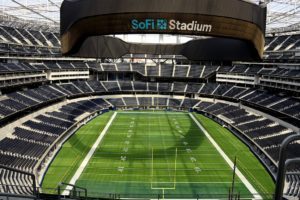
Thank You (21 Millions+) views, CC BY 2.0
FAA declares airspace around SoFi Stadium a ‘No Drone Zone’ on Super Bowl Sunday
By Jim Magill
The Federal Aviation Administration has declared SoFi Stadium in Inglewood, California, the site of Super Bowl LVI, as a No Drone Zone, in the time before, during and after the big game on Sunday.
The FAA has issued a two-part temporary flight restrictions (TFR) for all pilots of manned and unmanned aircraft on Super Bowl Sunday. Aircraft are prohibited from flying within one nautical mile and up to 3,000 feet in altitude around SoFi Stadium beginning 10 a.m. (all times are in Pacific Standard Time). Beginning at approximately 2:30 p.m. and extending to 8:30 p.m., the TRF will be expanded, prohibiting flights within 30 nautical miles (34.5 miles) of the stadium, from the ground up to 18,000 feet in altitude.
Unmanned aircraft pilots who violate the TFR face hefty penalties, including possible jail time, fines exceeding $30,000 and possible damage to or loss of their drone.
The FAA cited the hundreds of additional take-offs and landings expected to take place from Los Angeles-area airports on Sunday as one reason for the extensive TFR, although the growing number of incidents of unauthorized drone incursions near large sporting events in recent weeks has also raised the level of safety and security concerns.
The TFR will not affect regularly scheduled commercial flights taking off from and landing at Los Angeles International Airport (LAX). Emergency, medical, public safety and military operations aircraft will also be permitted to fly within the TFR, in coordination with air traffic control.
“You might hear it referenced as a ‘No Drone Zone.’ That’s the messaging we’re using at the FAA so that people understand that drones aren’t allowed to fly within TFR during that time,” said Kevin Morris, UAS coordinator. “The TFR that we’re talking about is one TFR and it’s valid for all types of aircraft.”
In addition to drone flights, other types of aerial activity that will be prohibited during the TFR include flight training activity and ultralight aircraft and glider flights.
Morris said the 30-mile radius restriction imposed for the time immediately before and after the big game is similar to the limits imposed on flights during previous Super Bowls.
“We had the same distances in Tampa and then a year prior to that, in Miami,” he said. The FAA works with its security partners in local law enforcement and the military to determine the required physical area and duration of the TFR, “so everybody can have the time and space needed to keep the airspace safe.”
In the case of Super Bowl LVI, the FAA’s security partners include the police departments of Inglewood and Los Angeles, the Los Angeles County Sheriff’s Department and the California Highway Patrol as well as numerous federal security agencies, such as the FBI, US Customs and Border Protection and the Department of Homeland Security.
“When you’re talking about identifying an unknown aircraft, whether that be a traditional aircraft or a drone that’s entering the TFR, identifying that aircraft, analyzing the threat that the aircraft provides and then mitigating that risk falls upon our security partners,” Morris said.
The FAA’s Super Bowl LVI Flight Advisory warns UAS operators who don’t comply with the applicable airspace restrictions of the TFR that the Department of Homeland Security, Department of Justice, and the Department of Defense “may take security action that results in the interference, disruption, seizure, damaging or destruction of unmanned aircraft deemed to pose a credible safety or security threat to protected personnel, facilities or assets.”
“Our message for Super Bowl Sunday is: ‘Enjoy the game but leave your drone at home,’” Morris said.
Detailed information for general-aviation and drone pilots is available on the FAA’s Super Bowl LVI web page.
Read more in-depth articles by Jim Magill:
 Jim Magill is a Houston-based writer with almost a quarter-century of experience covering technical and economic developments in the oil and gas industry. After retiring in December 2019 as a senior editor with S&P Global Platts, Jim began writing about emerging technologies, such as artificial intelligence, robots and drones, and the ways in which they’re contributing to our society. In addition to DroneLife, Jim is a contributor to Forbes.com and his work has appeared in the Houston Chronicle, U.S. News & World Report, and Unmanned Systems, a publication of the Association for Unmanned Vehicle Systems International.
Jim Magill is a Houston-based writer with almost a quarter-century of experience covering technical and economic developments in the oil and gas industry. After retiring in December 2019 as a senior editor with S&P Global Platts, Jim began writing about emerging technologies, such as artificial intelligence, robots and drones, and the ways in which they’re contributing to our society. In addition to DroneLife, Jim is a contributor to Forbes.com and his work has appeared in the Houston Chronicle, U.S. News & World Report, and Unmanned Systems, a publication of the Association for Unmanned Vehicle Systems International.
Miriam McNabb is the Editor-in-Chief of DRONELIFE and CEO of JobForDrones, a professional drone services marketplace, and a fascinated observer of the emerging drone industry and the regulatory environment for drones. Miriam has penned over 3,000 articles focused on the commercial drone space and is an international speaker and recognized figure in the industry. Miriam has a degree from the University of Chicago and over 20 years of experience in high tech sales and marketing for new technologies.
For drone industry consulting or writing, Email Miriam.
TWITTER:@spaldingbarker
Subscribe to DroneLife here.
https://dronelife.com/2022/02/10/the-super-bowl-is-a-no-drone-zone-hefty-penalties-for-violating-faa-tfr/
 Unmanned Aerial Vehicle The latest drone news
Unmanned Aerial Vehicle The latest drone news



